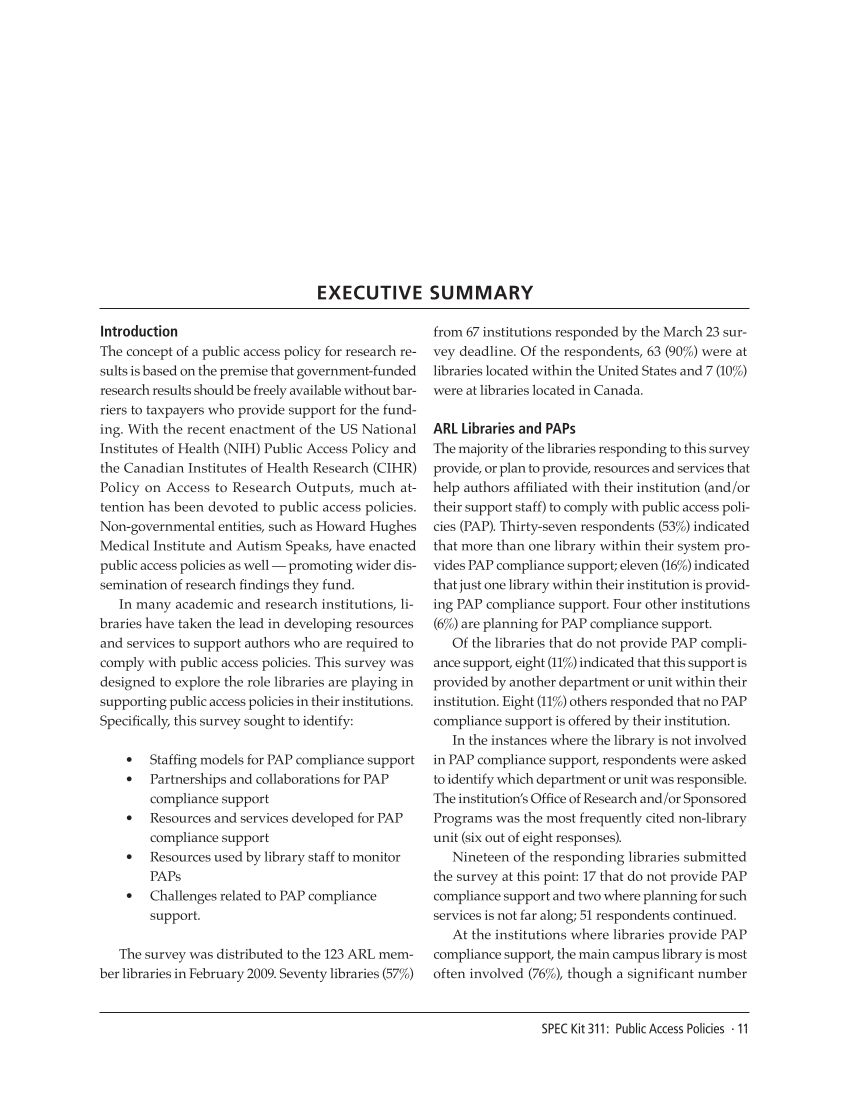SPEC Kit 311: Public Access Policies · 11
Introduction
The concept of a public access policy for research re-
sults is based on the premise that government-funded
research results should be freely available without bar-
riers to taxpayers who provide support for the fund-
ing. With the recent enactment of the US National
Institutes of Health (NIH) Public Access Policy and
the Canadian Institutes of Health Research (CIHR)
Policy on Access to Research Outputs, much at-
tention has been devoted to public access policies.
Non-governmental entities, such as Howard Hughes
Medical Institute and Autism Speaks, have enacted
public access policies as well — promoting wider dis-
semination of research findings they fund.
In many academic and research institutions, li-
braries have taken the lead in developing resources
and services to support authors who are required to
comply with public access policies. This survey was
designed to explore the role libraries are playing in
supporting public access policies in their institutions.
Specifically, this survey sought to identify:
• Staffing models for PAP compliance support
• Partnerships and collaborations for PAP
compliance support
• Resources and services developed for PAP
compliance support
• Resources used by library staff to monitor
PAPs
• Challenges related to PAP compliance
support.
The survey was distributed to the 123 ARL mem-
ber libraries in February 2009. Seventy libraries (57%)
from 67 institutions responded by the March 23 sur-
vey deadline. Of the respondents, 63 (90%) were at
libraries located within the United States and 7 (10%)
were at libraries located in Canada.
ARL Libraries and PAPs
The majority of the libraries responding to this survey
provide, or plan to provide, resources and services that
help authors affiliated with their institution (and/or
their support staff) to comply with public access poli-
cies (PAP). Thirty-seven respondents (53%) indicated
that more than one library within their system pro-
vides PAP compliance support eleven (16%) indicated
that just one library within their institution is provid-
ing PAP compliance support. Four other institutions
(6%) are planning for PAP compliance support.
Of the libraries that do not provide PAP compli-
ance support, eight (11%) indicated that this support is
provided by another department or unit within their
institution. Eight (11%) others responded that no PAP
compliance support is offered by their institution.
In the instances where the library is not involved
in PAP compliance support, respondents were asked
to identify which department or unit was responsible.
The institution’s Office of Research and/or Sponsored
Programs was the most frequently cited non-library
unit (six out of eight responses).
Nineteen of the responding libraries submitted
the survey at this point: 17 that do not provide PAP
compliance support and two where planning for such
services is not far along 51 respondents continued.
At the institutions where libraries provide PAP
compliance support, the main campus library is most
often involved (76%), though a significant number
Executive Summary
Introduction
The concept of a public access policy for research re-
sults is based on the premise that government-funded
research results should be freely available without bar-
riers to taxpayers who provide support for the fund-
ing. With the recent enactment of the US National
Institutes of Health (NIH) Public Access Policy and
the Canadian Institutes of Health Research (CIHR)
Policy on Access to Research Outputs, much at-
tention has been devoted to public access policies.
Non-governmental entities, such as Howard Hughes
Medical Institute and Autism Speaks, have enacted
public access policies as well — promoting wider dis-
semination of research findings they fund.
In many academic and research institutions, li-
braries have taken the lead in developing resources
and services to support authors who are required to
comply with public access policies. This survey was
designed to explore the role libraries are playing in
supporting public access policies in their institutions.
Specifically, this survey sought to identify:
• Staffing models for PAP compliance support
• Partnerships and collaborations for PAP
compliance support
• Resources and services developed for PAP
compliance support
• Resources used by library staff to monitor
PAPs
• Challenges related to PAP compliance
support.
The survey was distributed to the 123 ARL mem-
ber libraries in February 2009. Seventy libraries (57%)
from 67 institutions responded by the March 23 sur-
vey deadline. Of the respondents, 63 (90%) were at
libraries located within the United States and 7 (10%)
were at libraries located in Canada.
ARL Libraries and PAPs
The majority of the libraries responding to this survey
provide, or plan to provide, resources and services that
help authors affiliated with their institution (and/or
their support staff) to comply with public access poli-
cies (PAP). Thirty-seven respondents (53%) indicated
that more than one library within their system pro-
vides PAP compliance support eleven (16%) indicated
that just one library within their institution is provid-
ing PAP compliance support. Four other institutions
(6%) are planning for PAP compliance support.
Of the libraries that do not provide PAP compli-
ance support, eight (11%) indicated that this support is
provided by another department or unit within their
institution. Eight (11%) others responded that no PAP
compliance support is offered by their institution.
In the instances where the library is not involved
in PAP compliance support, respondents were asked
to identify which department or unit was responsible.
The institution’s Office of Research and/or Sponsored
Programs was the most frequently cited non-library
unit (six out of eight responses).
Nineteen of the responding libraries submitted
the survey at this point: 17 that do not provide PAP
compliance support and two where planning for such
services is not far along 51 respondents continued.
At the institutions where libraries provide PAP
compliance support, the main campus library is most
often involved (76%), though a significant number
Executive Summary
























































































































































































